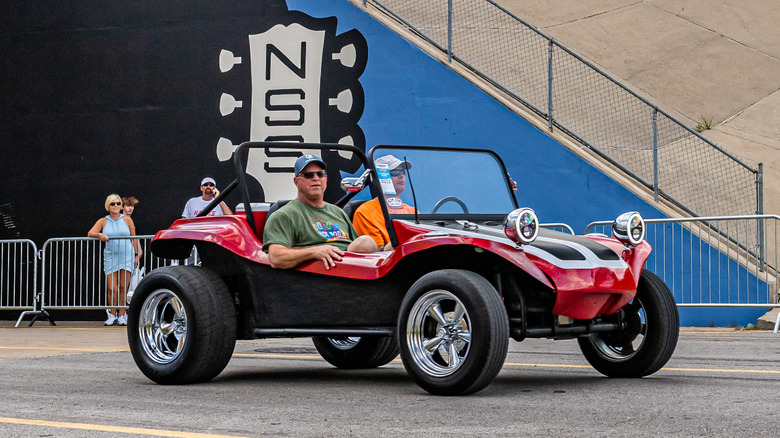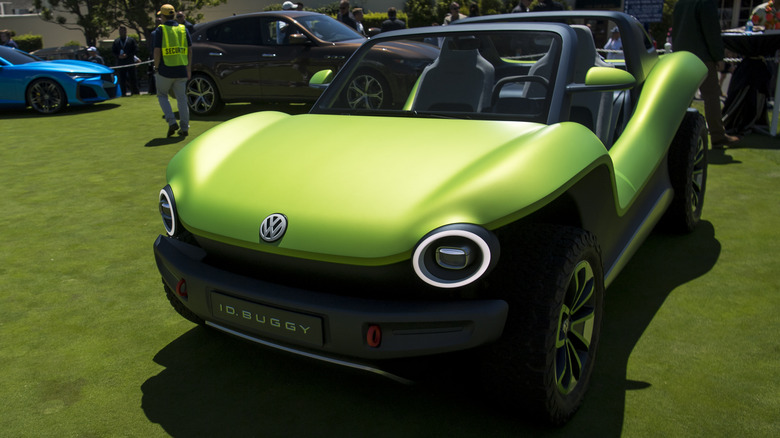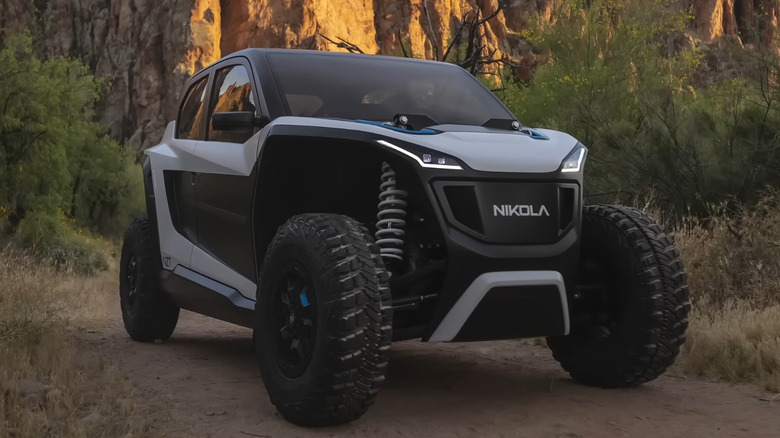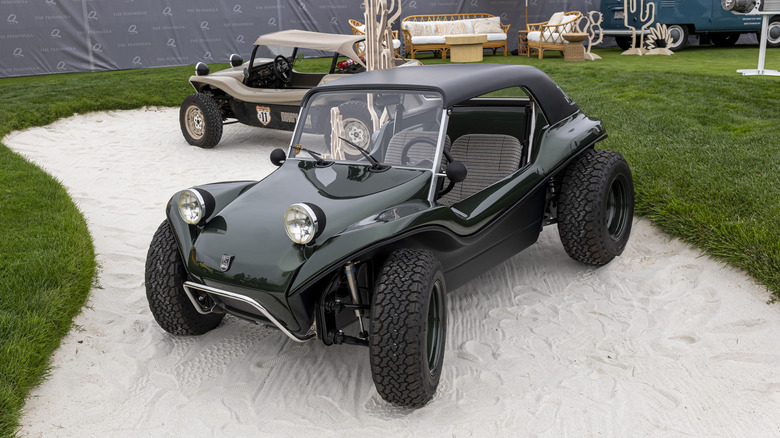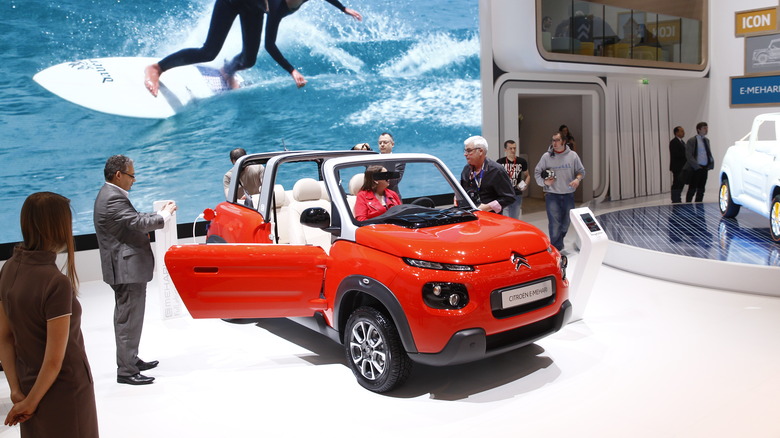6 Electric Buggies That Look Like A Total Blast To Drive
Cars are great when you're sticking to the road, but when it comes time to journey off the beaten path or onto the beach, nothing drives quite like a buggy. Now, with the advent of electric buggies, the popular vehicle has gotten a major modern makeover.
What draws people to electric buggies is the sheer joy of driving them. They provide a raw, unfiltered experience that's increasingly rare in modern vehicles. The open design of buggies, often without doors or a fixed roof, was and is famous for connecting the driver to the environment in a way few vehicles can. Now that the electric powertrains are here, they add to this experience by being super quiet, too.
When we picked the six coolest electric buggies, we didn't just look at what you can buy today. We also looked at discontinued models and even some that are just ideas for the future. Here are some electric buggies that look really fun to drive.
Volkswagen ID. Buggy
Unveiled at the 2019 Geneva International Motor Show, the ID Buggy is Volkswagen's electric nod to the iconic dune buggies of the 1960s, but with a modern twist. If looks are all you need, then the VW ID Buggy won't disappoint. It even won the Interior Design Best of Year Award for cars in 2019 for its minimalist, futuristic design.
The ID Buggy's performance is as good as it looks. Equipped with a rear-mounted electric motor, it offers 201 horsepower and 228 lb-ft of torque right from a standstill. This allows it to dart from zero to 62 mph in just 7.2 seconds, although the top speed is electronically capped at 99 mph. Besides the zippy beach drives, the next best thing about the ID Buggy is its 62 kWh battery with an estimated range of 155 miles, which makes it practical for longer journeys.
Volkswagen promised great off-road performance, too. The ID Buggy has big tires and strong protection underneath to handle rough terrain. The seats and other parts are waterproof and perfect for beach trips. As for buying one, the ID Buggy remains simply a concept car. With luck, though, its impressive specs and design could still be incorporated into a production vehicle one day.
Nikola NZT
Nikola is a company surrounded by scandal and controversy, with the electric truck company's founder recently being sentenced to four years in prison. Be that as it may, there's no denying that Nikola still had plans for an electric buggy that looked like it was a blast to drive: the Nikola NZT. Unfortunately, the company stopped working on it to shift focus to their hydrogen-powered truck. Since the NZT is paused and not scrapped, though, there's a chance we might actually get to drive it someday.
The NZT looks like a modern dune buggy but with a proper closed-door interior. The buggy was also planned to have four electric motors providing up to 590 horsepower. The company claimed it could go from zero to 60 mph in just four seconds. The completed NZT was promised to travel up to 150 miles on a full battery (125 kWh).
By looks alone, especially with the big 35-inch tires, you can tell that it was meant for off-road action. The buggy also had a ground clearance of 12 inches and an IP67 rating for all parts, meaning it could withstand submersion in water up to 1 meter for 30 minutes. The buggy was supposed to come out in 2021 with a hefty $80,000 price tag. Given the current state of Nikola, the future possibilities for the buggy are up in the air.
Meyers Manx 2.0
The Meyers Manx 2.0 Electric is a cool update of the famous Meyers Manx original. Bruce Meyers, who first made the Manx, is a big deal in buggy history. His buggies won races and even showed up in a Steve McQueen movie. After ceasing production in 1971, Meyers rekindled the brand in 2000, and new ownership in 2020 brought about the Manx 2.0. The new version looks a lot like the old buggy but with some fresh touches. It has sleek LED lights and a clean design at the back where the old engine used to be. Inside, it's simple but modern. The SlashGear team actually covered the Manx 2.0 back when this lovable electric dune buggy needed early owners to be willing guinea pigs.
Besides looking like a blast to drive, it's pretty fast, too. It has two electric motors and can hit 60 mph in about 4.5 seconds with the bigger battery. Speaking of batteries, you can choose between two sizes. The big one gives you 300 miles of driving before needing a charge, which is impressive, especially for a small, zippy buggy. You also get regenerative braking and electric power steering.
Starting at $74,000, the Manx 2.0 isn't exactly cheap, but it's a special kind of vehicle for the nostalgic enthusiasts out there. You can still reserve one with a $500 deposit through the Meyers Manx website. Full production is set to commence this year.
Polaris Ranger XP Kinetic
The 2024 Polaris Ranger XP Kinetic, starting at $30,000, is one of the less expensive buggies on this list. The design is both functional and eye-catching, as it comes with 29-inch pro armor tires and sits 14 inches off the ground.
The Kinetic is pretty powerful under the hood as well. Its 110-hp electric motor and 140 lb-ft of torque provide great performance, with a towing capacity of 2,500 lbs and a box capacity of 1,250 lbs. There are two battery options: the 14.9 kWh lithium-ion battery in the Premium model, with up to 45 miles of range, and the 29.8 kWh version in the Ultimate model, which can last up to 80 miles. When it comes to off-road capabilities, the buggy features what Polaris calls "true on-demand all-wheel drive, allowing for instant traction in challenging conditions. The high ground clearance and suspension system help, too.
For a buggy of this size, it's full of neat tech — Ride Command+ technology, including a 7" infotainment display, GPS mapping, and a rear camera. It also offers three driving modes: Eco+, Standard, and Sport. The Polaris Ranger XP Kinetic all-electric UTV features a few enticing cost-cutting claims, too, with the company saying the maintenance costs are up to 70% less compared to equivalent gas-powered alternatives.
Dacia Manifesto
We wouldn't be too far off calling the Dacia Manifesto the Cybertruck of buggies. Even Dacia calls it an SUV instead of a buggy. The Manifesto isn't strictly electric, but it's Dacia's philosophy that all their cars should be designed to work with all powertrains, including electric motors and batteries. Regardless, it's still a cool concept car that shows off what future Dacia vehicles might be like. Alas, we can only imagine how driving this feels.
In true buggy spirit, the Manifesto doesn't have doors, windows, or even a windshield. The more interesting bit is that it's made with a special material called Starkle — a recycled polypropylene with a distinctive flecked appearance, which is both environmentally responsible and ruggedly aesthetic.
Since the Manifesto is a buggy in concept only, we don't really know all the details about its speed and power. But we do know that it won't formally make it into production. However, we are likely to find certain elements of the Manifesto in other Dacia vehicles. For example, it has a system called "YouClip" for adding cool car accessories. The Manifesto also has some other quirky ideas, like seats that can turn into sleeping bags, airless tires, and a dashboard made with cork and rubber. You can even wash the inside with water.
Citroen E-Mehari
Here's a fun electric car with a cool history that you can actually drive — as long as you're in Europe. It's inspired by the old 1968 Mehari but is all about electric power and new ideas. It has a 67-bhp electric motor and can go about 124 miles before needing a charge. Citroen updated the E-Mehari in 2018, adding things like a hardtop roof, new colors, and better inside materials. Inside, it has special waterproof seats that are easy to clean. You might think that's great for a day out driving on the beach, but the Mehari is only two-wheel drive and weighs over 3,000 lbs, which means you're likely going to be stuck in the sand.
It was actually the first electric car to get a special French quality certification called "Origine France Garantie," which means that final assembly takes place in France and over 50% of its value is produced in France. The later model comes with airbags, an automatic high beam function, low tire pressure monitoring, and improved acoustic isolation. It also features a pedestrian warning sound system, which is essential given its ultra-silent operation.
The E-Mehari also has its quirks. It can be a bit bumpy, and reports say that turning isn't always smooth. The car costs over $30,000 for the basic model, but with a great look and solid specs, it's still a buggy worth checking out.
